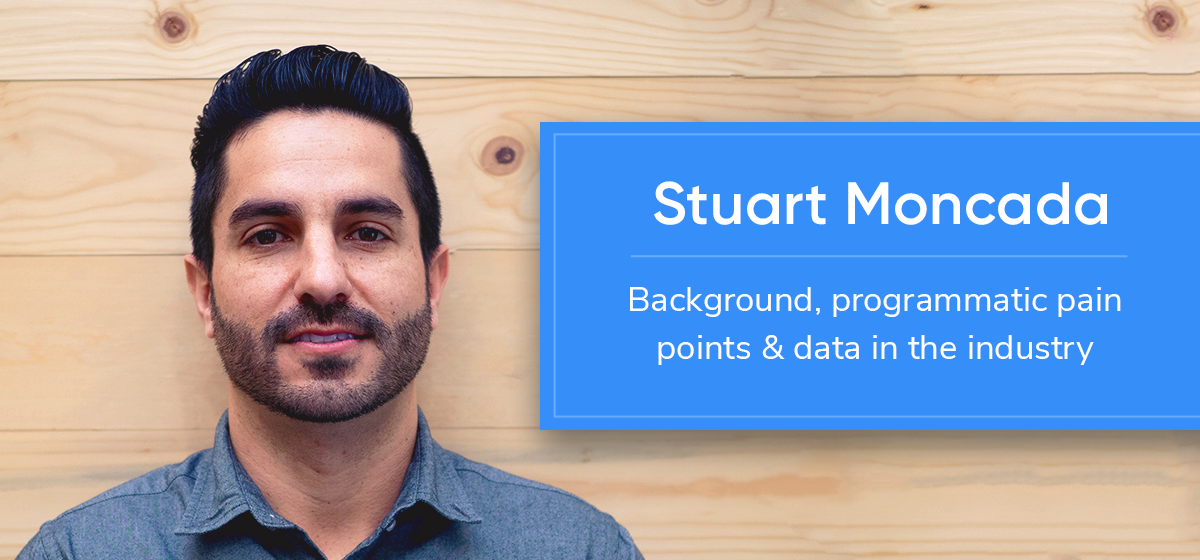We sat down to talk with our Director of Product Management, Stuart Moncada, about his background, current projects at Ad-Juster, and what he sees for the future of data in the industry.
What were you doing before Ad-Juster?
Before Ad-Juster, I was at OpenX, where we were building programmatic solutions to help publishers monetize their digital content from a demand partner perspective.
What did you particularly enjoy working on while you were there?
While I was at OpenX, I met with a lot of publishers to conduct product discovery interviews. The issues that came up most frequently were centered around unified reporting and fragmented data. So it was interesting to then come to Ad-Juster and work on solutions to the issues I had heard publishers complain about.
Why did you join Ad-Juster?
I was interested for a few reasons: it was the right company, the right role, and the right product. Ad-Juster is obviously in an industry that I'm familiar with [digital advertising], and it's the right size where I felt I could come in and make a big impact. Also, my product background and programmatic experience is a great fit for what Ad-Juster is doing now and hopes to do in the future.
From the discussions I had with publishers [while at OpenX], I knew that an advanced programmatic reporting solution would solve a huge pain point in the industry, so I was excited for the opportunity to lead that project.
Tell me a bit about your role here and what you're working on now.
I'm Director of Product Management—in this role I am directly responsible for our programmatic reporting solution and VERIFY, our tag scanning product. I’m also heading up the development of our next-gen Ad-Juster platform.
Right now, my biggest focus is on building out our new programmatic solution, which we’re excited to launch because it will solve many pain points in the industry and be a significant improvement over existing data analytics products.
What most excites you most about the new programmatic product?
Right now, I feel like there's a massive lack of awareness about what the different partners report—it seems that each partner reports something different and in a different format. Say an ad ops department works with 10 to 15 partners for monetization, it’s nearly impossible to manually pull and match that data frequently enough to be valuable. And on top of that, you have to stay up to date on the differences between each partner’s report to ensure your mapping is done correctly.
So, as part of this product’s development process, I've done a deep dive into the different programs, vendors, and demand partners that are out there—not only what they offer, but also what they report and the best data mapping strategies. I’m excited to build all of this research and insight into our programmatic solution so we can free up our clients’ time to focus on business-critical tasks like monetization and scaling up their ad business.
What would you say is the biggest challenge with programmatic advertising today?
I would say there are two big challenges. The first that comes to mind is fraud. And the obvious reason is that it costs billions of dollars a year; but also (and more importantly) because fraud erodes peoples’ trust which negatively impacts the entire digital ecosystem.
The second (and I think there’s less awareness about this issue) is how to manage and use data to make decisions. This gets a little bit of attention when people start talking about data science and AI [artificial intelligence], but there's just so much data that people really have no idea what to do. Everyone's just trying random things: finding new partners and removing partners; trying new formats and removing other formats; trying different CPMs and different price floors. But, because there are so many levers that can be moved and data points to watch, people don't really have a good understanding of what's moving the needle.
What are the initial hurdles to really be able to leverage data science to make smarter decisions?
Data science has been a buzzword for years but I almost feel like there's a hierarchy of needs before you achieve the pinnacle of true data science. The first step is to amass the data; the second step is to actually understand what you have in front of you. However, there is a lack of standards in digital advertising which makes things challenging because everyone uses their own definitions and methods in providing their own data. This means you don't get normalized data nor the same data from all your sources—two crucial pieces to actually analyzing your data in any meaningful way.
Once you get past those two steps, you can really start applying data science and AI to come up with solutions to specific problems. But right now, a lot of publishers are just concerned with the first part, “Hey, can I get the same data from all my partners in a consistent and reliable way?” Oftentimes, this means they’ll have to manually pull reports but this doesn't really lend itself well to data science—you need more automated and robust ways to collect that data and I think we're not there yet.
Why is normalization and standardization not farther along in the digital advertising industry?
I think it’s because a lot of other industries are either regulated or dominated by one or two major players that get to dictate or define the standards. I mean, you have a little bit of that with Google, but it’s not really the same: people may refer to Google as the standard, but it hasn't taken hold with competitors. For as big as they [Google] are, they can't single handedly move the industry on their own—there's too much fragmentation. I mean, just look at the LUMAscape—you’ll probably get a nose bleed.

© LUMA Partners LLC 2018
Haha, agreed.
Stay tuned for part 2 of the interview, where we dive into industry best practices.






